ALL ABOUT SEEDS
How Do Seeds Find a Good Place to Grow?, 1. Wind Dispersal
After the seeds have formed, the petals drop off. The flower dies. The ovary becomes a fruit. The seeds are inside the fruit. Some fruits can be soft and juicy. Others are hard and tough. The flesh of an apple is the ovary. Nuts have hard, tough ovaries. Sometimes, seeds do not form inside fruits. Strawberries have seeds covering the outside.
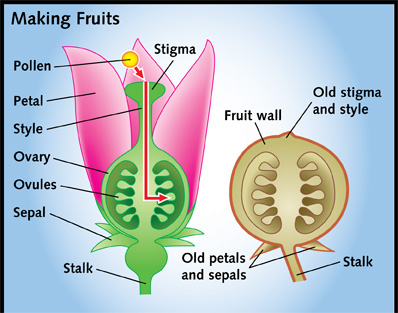 The pollen fertilizes the egg (left). The ovary forms a fruit (right).
The pollen fertilizes the egg (left). The ovary forms a fruit (right).
How Do Seeds Find a Good Place to Grow?
Plants spread their seeds. This is called seed dispersal. There are four main ways that plants do this.
1. Wind Dispersal
You may have seen sycamore seeds spinning in the air. Or maybe you have seen dandelion seeds blowing in the breeze. These seeds are moving away from their parent plants. Sycamore seeds have a “wing.” When they fall from a tree, they spin in circles. This helps them stay in the air longer than if they fell straight down.
A breeze or wind can blow the seeds. They will land far from the parent tree. Dandelion seeds are very light. They easily carry a long way on a breeze.
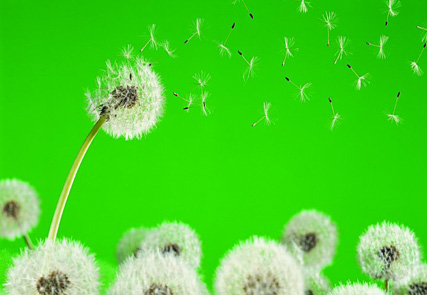 Each dandelion seed has a fluffy parachute. The parachute carries the seed in the air far from the parent plant.
Each dandelion seed has a fluffy parachute. The parachute carries the seed in the air far from the parent plant.
2. Animal Dispersal
Many people enjoy seeds and nuts. Animals and birds enjoy seeds and nuts, too. Seeds have a tough outer coat. When an animal eats a seed, the tough coat protects the seed. The seed does not break down in the animal's stomach. Instead, it passes out in the animal's waste. This helps it travel a long way from the parent plant.
Other seeds are sticky. Some have hooks on their surfaces. When an animal brushes past the plant, the seeds cling to the animal's fur. Eventually, the animal cleans its fur. The seed falls off.
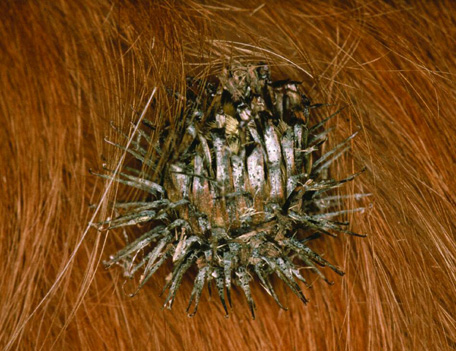 This seed is hooked onto a mammal's fur. Eventually it will drop off and it may grow into a new plant.
This seed is hooked onto a mammal's fur. Eventually it will drop off and it may grow into a new plant.
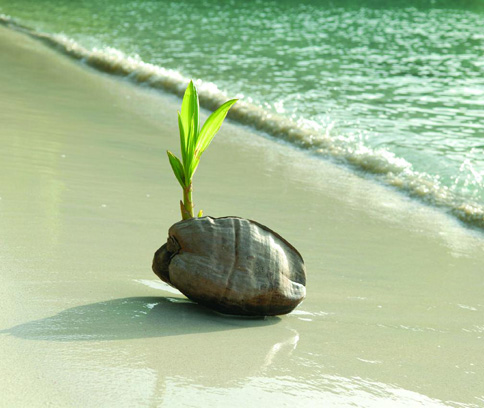 This coconut seed is sprouting into a new tree. It will grow roots and a long trunk. One day it may produce its own seeds.
This coconut seed is sprouting into a new tree. It will grow roots and a long trunk. One day it may produce its own seeds.
3. Water Dispersal
Coconuts are huge seeds. They are seeds that float on water. If coconuts fall on a beach, the sea may carry them away. They can survive in the water for many weeks. Eventually, they might wash up on another beach. There they can grow into a new coconut tree.
SLEEPY SEEDS
Seeds must have the right conditions to grow into a new plant. Until they do, they can lie inactive, or dormant, for many years. Being dormant is like being in a long sleep.
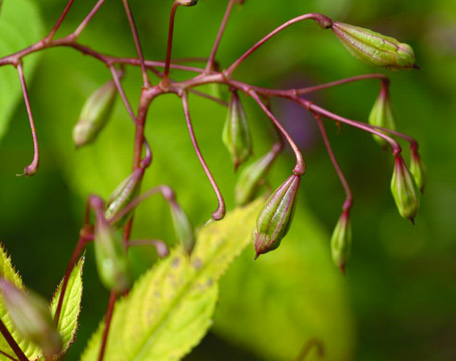 This Himalayan balsam plant forms pods. When the pod dries, the seeds get flung out far and wide.
This Himalayan balsam plant forms pods. When the pod dries, the seeds get flung out far and wide.
4. Self Dispersal
Some plants have clever ways to disperse their seeds. They do not need animals, water, or the wind. Peas form inside a pea pod. When the pod dries up, the peas are flung out. This is like a tiny explosion.
Why Does the Seed Move Away?
If a seed grows next to its parent plant, it may not grow very well. Both plants need energy from the Sun. If they are too close together, they could shade each other from the Sun. They both also need minerals from the soil. They could end up fighting each other for food and light.
ANCIENT DATES
Seeds can survive a long time. The oldest seed ever to grow into a plant was two thousand years old. It was a date palm. The date palm seed survived buried in the ground near the Dead Sea in Israel. Scientists thought that this type of date palm was extinct. Luckily, they were wrong!
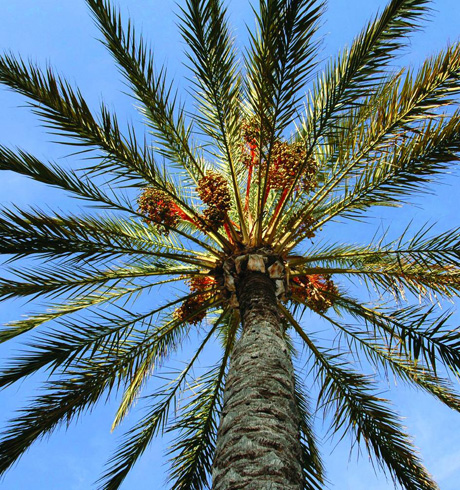
How Does a New Plant Grow?
If a seed is lucky, it will land on good soil. When the conditions are right, it may grow into a new plant. This is called germination. Seeds contain their own energy store. They do not need light at first. But they do need water, warm temperatures, and oxygen.
CLEVER SEEDS!
Seeds know which way is up. If you plant a seed upside down, the root will always grow down. The shoot will always grow up.
If a seed has the right conditions, it grows a root. The root pushes down into the soil. Then it grows a shoot. The shoot pushes up through the soil. When it reaches the air, its new leaves uncurl. At this point, the seed can use its leaves to trap energy from the Sun. It does not need its own energy store any more. Now, it carries out photosynthesis. This will help it grow into a strong, full-grown plant.
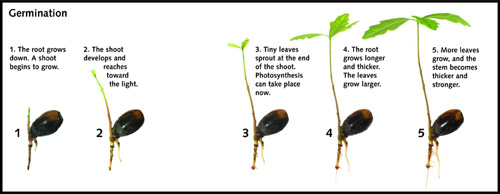 The growth stages of a seed—from young roots and shoot to a long stem and leaves.
The growth stages of a seed—from young roots and shoot to a long stem and leaves.
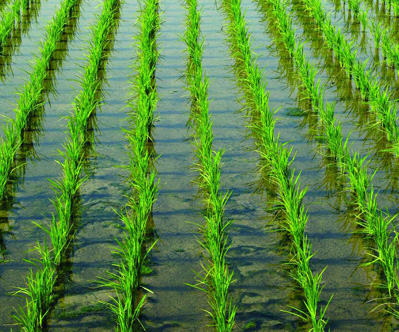 This crop of rice is sprouting. As soon as the green leaves develop, photosynthesis starts to take place.
This crop of rice is sprouting. As soon as the green leaves develop, photosynthesis starts to take place.
Additional topics
- PLANT SURVIVAL - How Do Plants Adapt?, How Do Plants Survive Extreme Conditions?, Deserts, Rainforests
- REPRODUCTION - Stamen, Carpel, Petals, Sepals, What Is Pollination?, Animal-Pollinated Plants, Wind-Pollinated Plants
- Other Free Encyclopedias